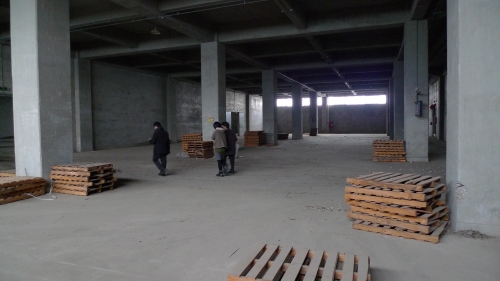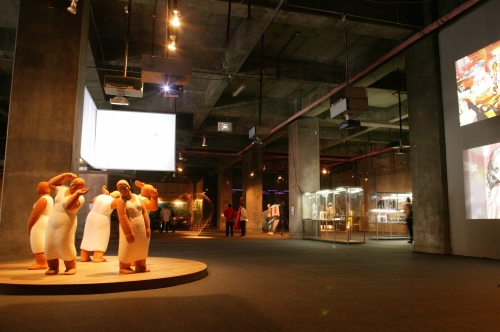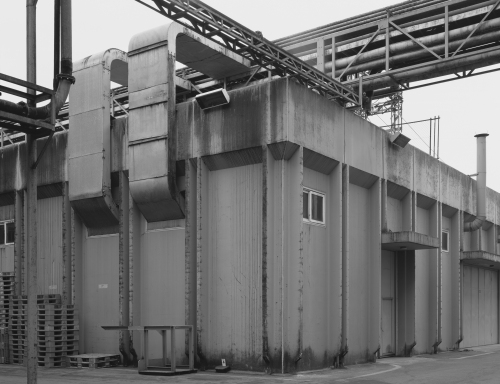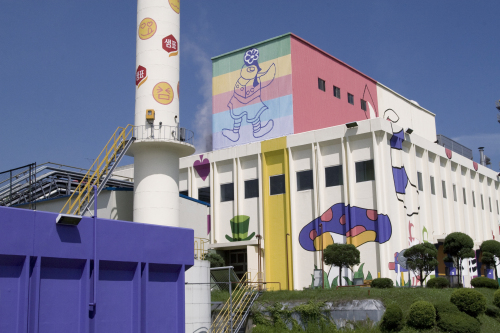Old tobacco factory hosts international craft biennale; soy sauce factory spruces upTwo of South Korea’s oldest and dullest-looking factories have been given a makeover.
Although they may not be as dazzling as Willy Wonka’s magical factory in Roald Dahl’s “Charlie and the Chocolate Factory,” the old tobacco factory in Cheongju, North Chungcheong Province, and the fully operating Sempio soy sauce factory in Icheon, Gyeonggi Province, have put on a fresh coat of paint.
Adding an artistic touch to industrial buildings is in fact a familiar project spotted around the world. The Tate Modern power plant-turned-museum in London; train station-turned-museum Musee d’Orsee in Paris and the coal industrial complex-turned-cultural complex in Essen, Germany are some of the best-known examples. In Seoul, the old Seoul Station reopened as Culture Station, Seoul 284, a complex of exhibition spaces and performance halls, in July.
With a whole new air, the old tobacco factory is gearing up to welcome visitors to the upcoming Cheongju International Craft Biennale next week and the soy sauce factory is already receiving visitors on group tours.
Cheongju International Craft Biennale 2011
Paint is peeling off at the old tobacco factory in Naedeok-dong, Cheongju city in North Chungcheong Province, which still smells of cigarette smoke. It is not exactly art-friendly yet, but the cement walls and spacious halls hint at what a great exhibition venue the building will become.
Opened in 1946, the factory was once the nation’s biggest cigarette manufacturer and made more than 10 billion cigarettes per year. For more than 60 years, it exported tobacco to 17 countries including Japan and Southeast Asia. About 2,000 employees worked in the 84,000 square meter factory site.
As the local tobacco industry started to wane in the late 1990s however, the raw materials factory closed in 1999 and the manufacturing line shut in 2004. The factory site was abandoned for years until Cheongju City recently bought it.
The factory is the main venue of the 2011 Cheongju International Craft Biennale which will be held from Sept. 21 to Oct. 30. It had hosted a small part of the biennale in 2005 as well.

The insides of the old tobacco factory before its transformation as the Cheongju International Craft Biennale venue.

A view of part of the 2005 Cheongju International Craft Biennale which was held inside the old tobacco factory. (Cheongju International Craft Biennale)
“Hosting the biennale in the old tobacco factory will bring out great results not only in terms of function but also economics, because the venue can be used as an exhibition hall even after the biennale is over. It will be an opportunity to reinvigorate the area, which has been neglected for about 10 years,” said Byeon Gwang-seob, head of Cheongju International Craft Biennale’s PR department, during a press conference at the factory last month.
Established in 1999, the biennale aims to promote Cheongju, home of “Jikjisimcheyojeol,” the world’s oldest metal type, and place it as the world’s craft design industry center. More than 150 local and international artists will participate in this year’s event. The artists will decorate the outside of the factory as well as fill it with craftworks.
Under the subtitle “not just new, but necessary,” this year’s biennale aims to explore the value of craft and the way it functions in today’s context. The main exhibition focuses on the essential quality and sustainability of craft by displaying 87 works including stained glass, wallpaper, tapestries, chairs and lamps.
The special exhibition, titled “Chairs, Flow,” examines the history of the chair. About 600 chairs will be showcased. The Finland pavilion will feature lifestyle-related craft by 110 artists and teams from the European guest country.
An extraordinary characteristic of this biennale is that it Cheongju citizens will be playing a big role in the overall event. They will run guide programs, run a variety of experience programs and even offer home-stay programs for foreign artists and visitors who will visit the city during the biennale.
Sempio Art Factory Project
In Icheon, Gyeonggi Province, the fully operating Sempio soy sauce factory has taken on a colorful and cheerful vibe. The walls and chimneys of every factory building are decorated with fun paintings that are inspired by Alice in Wonderland; traditional symbols of longevity; children’s scribbles and other ideas.
Park Jin-sun, head of Sempio Foods Company, turned the factory site into a gigantic work of public art. It took a year, since last August, to finish the “Sempio Art Factory Project.”
“We repaint the factory every three years. It used to be painted in gray because it is easy to manage and doesn’t look so messy. But looking at the gray factories one day, I thought that our employees might feel like they are coming to jail every day,” said Park at recent press conference.
So when the repainting season came last year, he decided to go for a change even though it meant more cost.
“We need to change our mindset that factory is a place to produce products to a place where employees work. I hope the soy sauce factory which has been reborn as a giant work of public art gives dreams and hopes to our workers,” said Park.

A view of the Sempio soy sauce factory site before the transformation. (Sempio)

Sempio soy sauce factories are colorfully decorated through the Sempio Art factory Project. (Sempio)
Sempio, which celebrated its 65th anniversary this year, accounts for 50 percent of the nation’s soy sauce market. The Icheon factory produces about 80,000 kiloliters of soy sauce.
A Korean up-and-coming artists group “Monsters of the East” gave colors and ideas to the dull gray walls. Six among a total of 780 artists from the group participated in the project ― four painted on the walls in different themes and two recorded the process each with photo and video.
“The factory will be transformed every three years from now on into new pieces of public art,” said Park.
Field trips to the factory are available. After making reservations, a free shuttle bus will pick up the visitors at a desired stop. On top of learning about how Sempio makes soy sauce, visitors will get a chance to taste world’s only soy sauce-cotton candies. Tours are only available in the mornings. Reservations can be made at www.sempio.com or by calling (031) 644-4615.
For more information on Cheongju International Craft Biennale 2011, visit www.okcj.org.
By Park Min-young (
claire@heraldcorp.com)









![[KH Explains] How should Korea adjust its trade defenses against Chinese EVs?](http://res.heraldm.com/phpwas/restmb_idxmake.php?idx=645&simg=/content/image/2024/04/15/20240415050562_0.jpg&u=20240415144419)